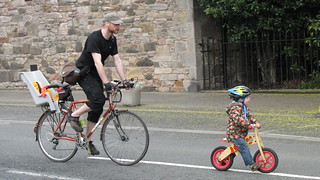@Morningsider, I know that in theory a raised table should be a continuation of the footway over the road, but the majority of the ones I see in Edinburgh are not tight enough, they're not steep enough and they don't give visual priority to the pedestrians. Cars seem able to take the new junction of Montague Street and St Leonards quite comfortably at speeds over fifteen mph.
I'm sending a personal response that will look something like the following, any comments (or anyone else wanting to comment https://citydev-portal.edinburgh.gov.uk/idoxpa-web/applicationDetails.do?activeTab=makeComment&keyVal=NPVCV3EWJA300) would be great!:
The pedestrianisation of much of 'the registers' area and the improvements to the public realm are welcome, as is the general intention of the designers to create a more pleasant environment for pedestrians. However the design of the West Register St/Princes St junction is extremely poor, and is fundamentally at odds with both the spirit and the letter of Edinburgh's street design guidance.
To place the junction in context, it lies between the St James centre and the majority of the Princes St shops and is among the most heavily used pedestrian streets in Edinburgh. Peak traffic use of the junction at present is 40 vehicles per hour (application transport appraisal), peak pedestrian use is presumably comfortably into the thousands of pedestrians per hour. In such a context the Edinburgh Street Design guidance insists on 'placemaking', emphacising pedestrian priority and that pedestrians should not be forced off desire lines.
This (mandatory) guidance seems to have been entirely ignored in the current design. There is no continuous footway across the junction, the raised table is set back from the junction taking pedestrians off their desire lines, and it is clear that vehicles have priority over pedestrians. These designs will most likely lead to a vast increase in the use of West Register Street by taxis and cars dropping people off, particularly given the large number of taxis which currently queue illegally outside the Balmoral hotel opposite.
I hope the developers will substantially revise their plans for this spot, regarding it not as a junction but as a continuous pavement across which vehicular access is allowed. In particular, there should be a continuous footway across the junction of the same material as the surrounding pavement which gives unambiguous priority to pedestrians and does not require them to deviate from a straight line. The ramps up to the junction for vehicles should be much steeper. Examples of such design in Edinburgh can be seen at the south west corner of George Square or at the junction of Fountainbridge with Fountain Park.
As a final point, it would be good if the 'no right turn' signs at this junction did not apply to cyclists, and that a small gap was made in the extended kerb dividing the two directions of traffic on Princes street in order that cyclists can make this manouvre.

 posts
posts
